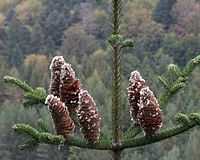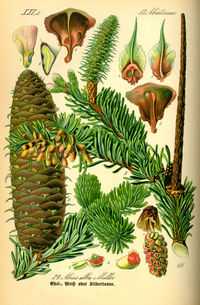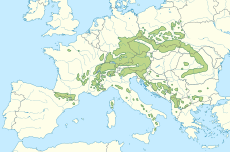Abies alba
- "Silver Fir" redirects here. For the Silver Fir of western North American, see Abies amabilis.
| Abies alba | |
|---|---|
 | |
| Abies alba in Silesian Beskids, Poland | |
| Conservation status | |
| Scientific classification | |
| Kingdom: | Plantae |
| Division: | Pinophyta |
| Class: | Pinopsida |
| Order: | Pinales |
| Family: | Pinaceae |
| Genus: | Abies |
| Species: | A. alba |
| Binomial name | |
| Abies alba Mill., 1768 | |
| Synonyms | |
|
A. nobilis A.Dietr. | |
Abies alba, the European silver fir or silver fir,[3] is a fir native to the mountains of Europe, from the Pyrenees north to Normandy, east to the Alps and the Carpathians, Slovenia, Croatia, Bosnia and Herzegovina and south to southern Italy and northern Serbia.[1]




Description
A. alba is a large evergreen coniferous tree growing to 40–50 metres (130–160 ft) (exceptionally 60 metres (200 ft)) tall and with a trunk diameter of up to 1.5 metres (4 ft 11 in). The largest measured tree was 68 m tall and had a trunk diameter of 3.8 metres (12 ft). It occurs at altitudes of 300–1,700 metres (980–5,580 ft) (mainly over 500 metres (1,600 ft)), on mountains with a rainfall of over 1,000 millimetres (39 in).
The leaves are needle-like, flattened, 1.8–3 centimetres (0.71–1.18 in) long and 2 millimetres (0.079 in) wide by 0.5 millimetres (0.020 in) thick, glossy dark green above, and with two greenish-white bands of stomata below. The tip of the leaf is usually slightly notched at the tip. The cones are 9–17 centimetres (3.5–6.7 in) long and 3–4 centimetres (1.2–1.6 in) broad, with about 150-200 scales, each scale with an exserted bract and two winged seeds; they disintegrate when mature to release the seeds. The wood is white, leading to the species name "alba".[3]
It tends to forms woods with other firs and beeches.[3] It is closely related to Bulgarian Fir (Abies borisiiregis) further to the southeast in the Balkan Peninsula, Spanish Fir (A. pinsapo) of Spain and Morocco and Sicilian Fir (A. nebrodensis) in Sicily, differing from these and other related Euro-Mediterranean firs in the sparser foliage, with the leaves spread either side of the shoot, leaving the shoot readily visible from above. Some botanists treat Bulgarian Fir and Sicilian Fir as varieties of Silver Fir, as A. alba var. acutifolia and A. alba var. nebrodensis respectively.
Ecology
Silver Fir is an important component species in the Dinaric calcareous Silver Fir forest in the western Balkan Peninsula.
Its cone scales are eaten by the caterpillars of the tortrix moth Cydia illutana, while C. duplicana feeds on the bark around injuries or canker.
Uses
A resinous essential oil can be extracted. This pine-scented oil has soothing qualities, and is used in perfumes, bath products, and aerosol inhalants.[3] Its branches (including the leaves, bark and wood) were used for production of spruce beer.[4] Silver Fir is the species first used as a Christmas tree, but has been largely replaced by Nordmann Fir (which has denser, more attractive foliage), Norway Spruce (which is much cheaper to grow), and other species. The wood is moderately soft and white, used for general construction and paper manufacture.
References
- ↑ 1.0 1.1 Farjon, A. (2014). "Abies alba". IUCN Red List of Threatened Species. Version 2014.2. International Union for Conservation of Nature. Retrieved 28 August 2014.
- ↑ http://www.theplantlist.org/tpl1.1/record/kew-2609691
- ↑ 3.0 3.1 3.2 3.3 Gualtiero Simonetti (1990). Stanley Schuler, ed. Simon & Schuster's Guide to Herbs and Spices. Simon & Schuster, Inc. ISBN 0-671-73489-X.
- ↑ London Medical Gazette, September 23th, 1837, page 935: https://books.google.si/books?id=TPQaAQAAMAAJ
- Kunkar, Alp; Kunkar, Ennio. Le piante officinali della Calabria (in Italian). Laruffa Editore. ISBN 88-7221-140-9.
External links
| Wikimedia Commons has media related to Abies alba. |
- theplantlist.org: Abies alba Mill.
- iucnredlist.org: Abies alba
- conifers.org: Abies alba
- botany.cz: Abies alba Mill
- photomazza.com: Abies alba
- conifersaroundtheworld.com: Abies alba - European White Fir.
- pfaf.org: Abies alba Mill.
- monumentaltrees.com: The thickest, tallest, and oldest European silver fir trees (Abies alba)
- baumkunde.de: Weiß-Tanne (Abies alba) | In German
